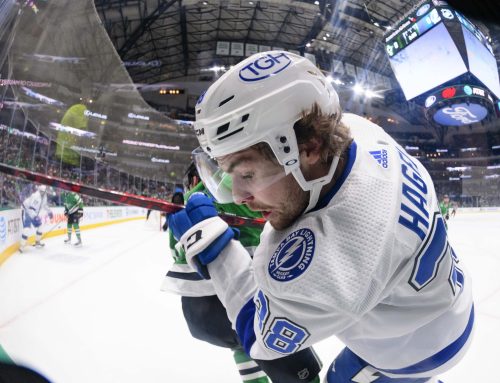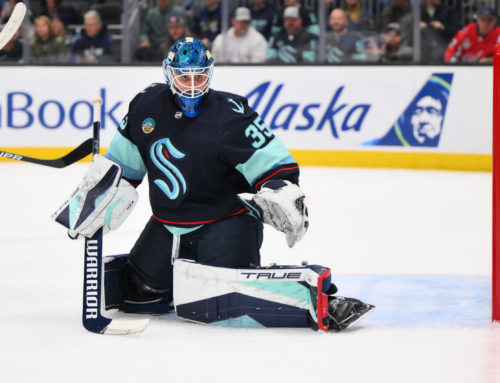Goldipucks and the Three Skaters: Suter, Johnsson & Reinhart
Rick Roos
2019-04-03

Welcome back to another installment of “Goldipucks and the Three Skaters.” For first time readers, or those needing a refresher, this column is a play on the Goldilocks and the Three Bears story, except instead of there being three bowls of porridge I’m covering three skaters and declaring one too hot (i.e., doing unsustainably better than he should), another too cold (i.e., doing unsustainably worse), and a third “just right” (i.e., producing where he should be). I also assign each a 1-10 rating, indicating just how hot (rated 7-10, where 10 is the most unsustainably hot), how cold (rated 1-4, where 1 is the most unsustainably cold), or how “just right” (rated 4-7, where 5.5 is the most “just right”) he is.
The three skaters featured this week are Ryan Suter, Andreas Johnsson, and Sam Reinhart. Stop here and see if you can guess which one is too hot, which is too cold, and who is “just right,” then see if you’re correct after you read on.
Ryan Suter
Although he turned 34 in January, if you look at his production Suter doesn’t appear to be slowing down, having posted the 13th most points among all blueliners since the start of 2015-16. Naturally, this has poolies wondering if he could be the type who defies father time and continues to produce solid scoring, or whether, instead, he might be vulnerable to seeing his totals drop, and soon. It turns out that looking at data, some of Suter’s key numbers are trending down and he’s unsustainably benefitting quite a bit from the absence of Matt Dumba and unsustainable good luck, which collectively mean he’s unlikely to be able to continue at this pace in future seasons.
For starters, Suter’s SOG rate is down for the third consecutive season, having dropped from 2.29 in 2015-16, to 2.00 in 2016-17, to 1.91 last season, to 1.68 per game for 2018-19. Moreover, Suter had never failed to average 0.5 SOG per game on the PP since coming to Minnesota, yet this season is on pace for two every five games despite Matt Dumba missing most of the campaign and that fact that in the 31 games before Dumba got hurt on December 15th Suter played over 3:30 on the PP in only eight, compared to 18 times in the 43 subsequent games. So Suter figures to see less PP time once Dumba is back to full health in 2019-20, and that should further hurt his already apparently waning PP production.
It’s also notable that in prior seasons which saw Suter post 50+ points, his ratio of secondary assists versus primary was at or just above even, while this season he’s on pace for it to be nearly 1.75 to one (i.e., 25 vs. 14), which isn’t a good sign. Another concern is Suter’s offensive zone starting percentage this season is above 55% – likely due to Dumba missing from the line-up – after being 50% or less in five of the previous eight campaigns, including each of the prior two.
Lastly, age is working against Suter, as since 2000-01 a total of 11 defensemen posted 45+ points in their age 34 season, compared to only nine hitting that threshold in their age 35 campaign, and with only one of the nine (Mark Giordano this season) having done so since the 2011-12 campaign. And remember how Suter’s SOG rate is 1.68 per game for 2018-19? That’s notable because all the 35-year-old d-men who posted 45+ points in a season since 2000-01 averaged at least 1.81 SOG per game in doing so, with seven of the nine being at 2.13 per game or greater.
Given the above, it’s not too difficult to conclude that Suter is TOO HOT. Most likely he’ll have another 40 point season or two in him; however, chances are his days of 50+ points are done and even 45+ could be a tall order. So I’m assigning him a rating of 8.
Andreas Johnsson
Lost amid the attention paid to higher profile Toronto star forwards, is the fact that Johnsson is scoring at a 48 point rate and has been getting regular shifts alongside Auston Matthews. But will Johnsson be able to maintain that coveted spot, and, if so, could he produce even better? I believe the answer to both questions is yes.
First and foremost, Johnsson’s season-long production obscures that he started with three points in his first 18 games, meaning since then he’s posted 39 in 56 contests. It’s a similar story with his ice time, as he averaged a mere 11 minutes per game in the first quarter before jumping to 13 minutes per game in the second and third and rising to 15:01 per game since the start of the last quarter of the season. And beyond just a rise is scoring to accompany additional ice time, he’s shooting the puck more, with two SOG per game in the season’s final quarter.
Another key is Johnsson makes Matthews better (more on this in a second), yet not at the expense of Johnsson’s own scoring. Case in point is that Johnsson’s IPP is 71.2% despite playing so often with Matthews, showing that Johnsson isn’t merely along for the ride but actually showing a nose for scoring. That bodes well for him to be able to raise his scoring pace further.
In terms of making Matthews even better, Matthews has a higher Scoring Chances For when playing with Johnsson than when not, with it being a similar story in terms of High Danger Scoring Chances. Those scoring chances also have translated into actual goals, as Matthews has 65% of his goals scored while playing with Johnsson despite the two sharing the ice for 47% of Matthews’ shifts.
In terms of the PP, although over 25% of the man advantage time Johnsson has received has been with Matthews, only one of his six PPPts came while Matthews was on the ice. The bad news is that might not lead to Johnsson gaining a foothold on a PP1 spot; however, it shows he still can score with the man advantage even if put on PP2. And despite receiving the 184th most PP minutes among NHL forwards, Johnsson’s PPPts rank is tied for 171st.
Beyond these factors, and notwithstanding his slow start, Johnsson has a points per 60 scoring rate that puts him ahead of, among others, Jeff Skinner, Jonathan Marchessault, Evander Kane, and Filip Forsberg. Moreover, all but one player (Joe Thornton) who ranks above him in this area (and who’s played 40+ games) averages at least 30 seconds more PP time per game, proving Johnsson has done more with less and underscoring his ability to get points on goals scored while he’s on the ice.
Based on how he apparently makes Auston Matthews a better player and at the same time is also able to score in his own right, plus has season-long stats dragged down by his slow start, Johnsson is TOO COLD. He’s not very cold though since there’s still the issue of him being unlikely to penetrate PP1. Accordingly, Johnsson gets a rating of 3, suggesting next season he should be a 60-65 point player.
Sam Reinhart
With this being his “magical fourth year” and on a vastly improved Buffalo team, many figured Reinhart would easily best his career high in points. And sure enough, he’s done so, although perhaps not quite reaching the scoring heights some might have expected heading into this season, especially on the heels of a scorching 37 points in his last 41 games to end 2017-18.
The question thus becomes, is what we’re seeing from Reinhart in 2018-19 what we should expect him to produce going forward, or instead just a stepping stone on his way to greater things? From where I sit, Reinhart has the talent to do more, yet his situation is such that he’s likely to produce roughly the same in future seasons as he is in 2018-19.
In the real NHL, versatile players are great assets to their teams. Yet that same versatility often leads to subpar fantasy results. In the case of Reinhart, he’s able to play both wing and center; and in actuality, what that has meant in 2018-19 is him both hitting the jackpot by playing wing on a line with Jack Eichel but also centring Buffalo’s second or even third line alongside far less talented players. It’s similar to the what happened with Brayden Schenn during his tenure with Philly, where when Schenn played wing on a line with skilled players he produced well, but when forced to center the team’s less talented players he usually struggled.
Looking at Reinhart’s deployment for 2018-19, he’s skated with Jack Eichel for about 55% of his total even-strength shifts, yet that’s where 70% (i.e., 33 of his 47) even strength points were accumulated. From that we can see if Reinhart was stapled to Eichel he’d be able to do more; however, the reality is he sees nearly as much time centring other lines – with weaker players – thus bringing down his totals. And with no apparent end in sight to this deployment pattern, Reinhart likely will continue to produce like he is now – in droves when on a line with Eichel but sparingly otherwise.
Another concern is that Reinhart’s IPP this season is 64.6%, which, despite it not being that great, marks a career high. With now over 300 NHL games to his credit and no season even close to the key 70% IPP threshold which my research suggests is indicative of a player who already is – or can become – great, Reinhart simply might not the type of player who has a strong nose for scoring. This is not good to see in general, but especially considering the 45% of shifts he sees without Eichel, where, if he was a dominant player, he should have a higher IPP and more points to show for it. Reinhart also has an offensive zone starting percentage over 61% this season, marking the first time it’s been above even 54% in his career. With his OZ% unlikely to go much higher, he probably cannot count on more points coming due to that factor. This having been said, Reinhart has twice as many primary assists as secondary this season (28 to 14), so that could help pad his scoring a bit in future seasons or offset points he might lose due to these other factors.
Based on the data and his suboptimal – for fantasy at least – deployment, Reinhart’s production level for 2018-19 is JUST RIGHT, and I’ve assigned him a rating of 5, suggesting that he still might be able to eke out a few more points per seasons, due mainly to his primary assist rate and the very real possibility he hasn’t peaked yet at age 23.
**
Mailbag questions needed
I’m always in need of questions about fantasy hockey for me to answer in my monthly mailbag column. There are two ways for you to get your questions to me – (1) email it to [email protected] with “Roos Mailbag” in the subject line, or (2) send me a private message at the DobberHockey Forums with your question (my username is “rizzeedizzee”.





 PHI
PHI WSH
WSH FLA
FLA MIN
MIN N.J
N.J T.B
T.B BUF
BUF DAL
DAL MTL
MTL NYR
NYR CBJ
CBJ TOR
TOR NYI
NYI DET
DET STL
STL WPG
WPG CHI
CHI VAN
VAN SEA
SEA COL
COL NSH
NSH BOS
BOS EDM
EDM CAR
CAR UTA
UTA OTT
OTT CGY
CGY PIT
PIT ANA
ANA S.J
S.J VGK
VGK L.A
L.A
